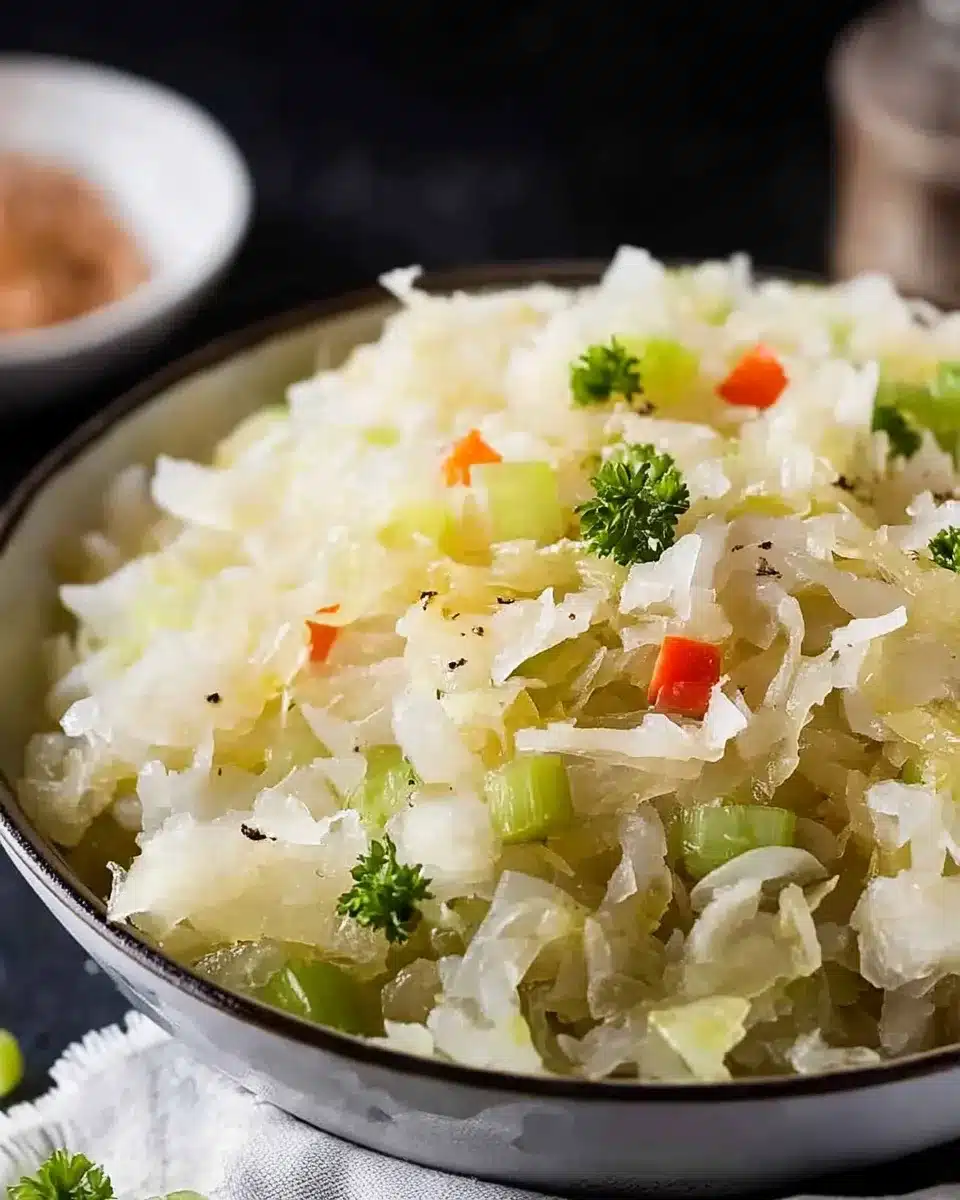Sauerkraut Salad: A Flavor-Packed Crunch

When it comes to vibrant, tangy dishes that awaken your taste buds, few can rival the delightful crunch of a well-crafted salad featuring fermented cabbage. Sauerkraut salad brings together the tangy depth of sauerkraut with fresh, colorful ingredients, making it a refreshing addition to any meal. This versatile dish can be tailored to your preferences, allowing for a myriad of variations—think zesty additions like apple slices for sweetness or fresh herbs like dill or parsley for an aromatic touch.
For those seeking to elevate their preparation skills, consider some expert tips: rinse the sauerkraut briefly to tone down the saltiness or toss in roasted seeds for an added crunch. Whether as a side dish, a light lunch, or a topping for grilled meats, this salad is not only easy to prepare but also packs a punch of probiotics that contribute to gut health. Get ready to explore the endless possibilities of this delicious and nutritious salad!
Ingredients for Sauerkraut Salad:
This delightful Sauerkraut Salad is packed with flavor and is a perfect side dish or light meal. Below are the precise ingredients you will need to serve 8–10 people.
Main Ingredients
- 32 ounces of sauerkraut, drained and rinsed to remove excess salt
- 1 medium onion, thinly sliced (preferably red for a pop of color)
- 2 medium carrots, grated or julienned for texture
- 1 red bell pepper, diced
- 1 green bell pepper, diced
- 1 cup cherry tomatoes, halved
- 1 cup cucumber, diced (English cucumber works best for crunch)
Dressing Ingredients
- 1/3 cup olive oil, to add richness
- 1/4 cup apple cider vinegar, for a tangy flavor contrast
- 1 tablespoon Dijon mustard, to enhance the depth of flavor
- 1 teaspoon sugar, optional, to balance acidity
- Salt and black pepper to taste (about 1 teaspoon of each)
Herbs and Optional Add-Ins
- 1/4 cup fresh parsley, chopped, for freshness
- 2 tablespoons fresh dill, chopped, to elevate the dish
- 1 teaspoon caraway seeds, optional, for a traditional touch
- 1/2 cup grated cheese, such as feta or sharp cheddar, for additional flavor (optional)
- 1/2 cup sliced olives, (black or green based on preference) to add saltiness
Variations to Consider
If you want to explore different flavor profiles, consider the following variations:
- For a sweeter twist, add 1/4 cup of raisins or chopped apples.
- For a spicier kick, incorporate chopped jalapeños or a dash of hot sauce to the dressing.
- Replace olive oil with avocado oil for a different flavor and health benefits.
This Sauerkraut Salad is not just versatile but also brimming with nutrients and probiotics, making it an excellent choice for a healthy diet!
How to prepare Sauerkraut Salad:
Making a refreshing and zesty Sauerkraut Salad is straightforward. Follow these easy steps for a delightful dish.
Gather Your Ingredients
Start by gathering all your ingredients. You will need 2 cups of sauerkraut, 1 cup chopped bell peppers (any color), 1/2 cup diced red onion, 1/2 cup shredded carrots, and 1 cup diced cucumbers. Fresh herbs such as parsley or dill can enhance the flavor.
Choose the Right Bowl
Select a large mixing bowl. Ensure it is clean and dry to prevent any contamination.
Combine the Sauerkraut and Vegetables
Open the can or package of sauerkraut and drain any excess liquid. Add the sauerkraut to the mixing bowl. Toss it gently to break apart any clumps.
Next, add the chopped bell peppers into the bowl. Mix them in slightly so they distribute evenly.
Now, introduce the diced red onion to the mix. This will add a sharp flavor.
Incorporate the shredded carrots next. Their sweetness will balance the sourness of the sauerkraut.
Finally, add the diced cucumbers. They bring a refreshing crunch to your salad.
Prepare the Dressing
In a separate bowl, combine 1/4 cup olive oil, 2 tablespoons apple cider vinegar, 1 tablespoon Dijon mustard, and salt and pepper to taste. Whisk these ingredients until they are well blended.
Dress the Salad
Pour the prepared dressing over the vegetable mixture. Use a spatula to gently toss everything together. Ensure all the vegetables are evenly coated.
Add Fresh Herbs
Chop any fresh herbs you have chosen. Sprinkle them over the salad. Stir again to combine the flavors.
Chill and Serve
Cover the bowl with plastic wrap or a lid. Place the salad in the refrigerator for at least 30 minutes. This chilling time allows the flavors to meld together.
When ready to serve, give the salad a final toss. Taste and adjust seasoning if necessary, and serve chilled. Enjoy your delicious and nutritious dish!
Tips for the Perfect Sauerkraut Salad
Maintain the Right Temperature
To achieve a refreshing and flavorful dish, keep your salad chilled. Start by refrigerating the sauerkraut before mixing. The cooler temperature enhances the natural crunch and tang of the ingredients. Aim to serve your salad cold; this will ensure that all the flavors meld beautifully, making every bite enjoyable. If you prepare it in advance, store it in an airtight container in the refrigerator for at least an hour before serving.
Choose Quality Ingredients
The key to a scrumptious salad lies in the ingredients. Begin with fresh vegetables. Use crisp bell peppers, zesty red onions, and vibrant carrots to add color and nutrition. If possible, select organic produce to maximize flavor and health benefits. When it comes to the sauerkraut itself, opt for high-quality, unpasteurized varieties. This option retains beneficial probiotics that promote gut health, making your salad not just tasty but also nutritious. Check that the sauerkraut has a lively crunch without excessive brine to avoid sogginess.
Substitutions for Dietary Restrictions
Not everyone can or wants to enjoy the same ingredients. For those with gluten sensitivities, use gluten-free soy sauce or coconut aminos instead of standard sauces. Vegetarians or vegans will appreciate a plant-based mayonnaise if you choose to include this element for creaminess. Additionally, consider swapping out refined sugars for natural sweeteners like agave syrup or maple syrup for a healthier alternative. This adjustment benefits those avoiding refined sugars and adds a delightful sweetness.
Experiment with Flavor Enhancements
Feel free to spice things up! Add herbs like dill or parsley to elevate the taste. You could also toss in some seeds, like sunflower or pumpkin seeds, for crunch and added nutrition. A sprinkle of cumin or smoked paprika can introduce a delightful twist on the classic profile. These adjustments allow you to customize the dish to your liking while keeping the core essence intact.
By following these tips, you will craft a truly delicious and nourishing offering that everyone can enjoy. Happy cooking!
Storage Tips for Sauerkraut Salad:
Proper storage techniques help preserve the freshness and flavor of your sauerkraut salad. Here’s how to ensure it stays delicious for as long as possible.
Optimal Storage Conditions
Store your sauerkraut salad in an airtight container. This simple step prevents exposure to air, reducing the risk of spoilage. Glass containers work excellently since they do not retain odors like plastic. If you use plastic, choose high-quality, BPA-free options to avoid contaminants. Place a tight-fitting lid on the container to seal in freshness.
Ideal Refrigeration Temperature
Keep the salad in the refrigerator. The ideal temperature for storing food is below 40°F (4°C). Ensure your fridge maintains a consistent temperature. Fluctuating temperatures can accelerate spoilage. Avoid placing your sauerkraut salad in the door of the fridge, where temperatures tend to vary. Instead, choose a shelf toward the back for more stable conditions.
Understanding Shelf Life
Consume your sauerkraut salad within 3 to 5 days for the best quality. Over time, even when stored properly, ingredients may lose flavor and texture. If you notice any signs of spoilage, such as a change in smell, color, or texture, it’s best to discard the salad to avoid foodborne illness. Always trust your senses when determining freshness.
Freezing for Long-Term Storage
If you have excess salad you can’t consume within the recommended time frame, consider freezing it. Portion out servings into freezer-safe containers or bags, leaving some space for expansion. Label the containers with the date for easy tracking. When you’re ready to enjoy the salad again, thaw it in the refrigerator overnight. However, expect some texture changes after thawing, especially in fresh vegetables.
Reviving Leftovers
When you remove sauerkraut salad from storage, give it a gentle toss before serving. This helps recombine any separated ingredients, restoring its original look and taste. If the salad appears dry, add a small amount of dressing or a splash of vinegar to refresh it.
Storing your sauerkraut salad using these tips will ensure you enjoy its delightful flavors while minimizing food waste. Keep these guidelines handy for maximum freshness!
Related Recipes to Sauerkraut Salad
If you enjoy the tangy taste and crunchy texture of sauerkraut salad, you’ll love these complementary recipes. Each dish highlights fresh ingredients and seasonal flavors that enhance or complement the main elements of sauerkraut.
First, consider trying Coleslaw. This classic side dish features shredded cabbage and a creamy dressing. Like sauerkraut salad, coleslaw brings a crunchy texture to the table. It’s often served at barbecues or picnics, making it a great companion for grilled meats. The contrast between the creamy dressing and the tartness of sauerkraut creates a delightful mix when served together.
Another excellent choice is German Potato Salad. Made with warm potatoes, bacon, and a tangy vinaigrette, this dish pairs beautifully with the vibrant acidity of the salad. The hearty nature of potato salad complements the lighter, crisp textures of the sauerkraut offering a balance between the two.
For a lighter option, try a Cucumber and Tomato Salad. Fresh cucumbers and juicy tomatoes provide a refreshing crunch similar to the salad while introducing different flavors. This recipe’s bright and refreshing elements enhance the tanginess of sauerkraut, creating an overall balanced meal.
Lastly, Bratwurst with Sauerkraut makes for a delicious main dish. The savory, spiced sausage pairs perfectly with the tartness of the salad. The combination emphasizes the flavors of both dishes, creating a satisfying meal that brings out their best qualities.
Each of these recipes allows you to explore flavors that harmonize with sauerkraut salad while adding variety to your dining experience.
Frequently Asked Questions:
What is Sauerkraut Salad made of?
Sauerkraut salad typically includes fermented cabbage, commonly known as sauerkraut, mixed with various ingredients such as diced vegetables, herbs, and sometimes proteins like ham or sausage. It is often dressed with a tangy vinaigrette or a creamy dressing to enhance its flavors.
Is Sauerkraut Salad healthy?
This dish can be quite nutritious, as it is rich in probiotics due to the fermentation process of the cabbage. Sauerkraut is also low in calories and high in vitamins C and K. When combined with fresh vegetables and healthy fats in the dressing, it can make for a balanced, healthful side dish or meal.
Can I customize my Sauerkraut Salad recipe?
Absolutely! One of the great aspects of sauerkraut-based salads is their versatility. You can customize the recipe by adding your favorite ingredients such as shredded carrots, bell peppers, or even some fruit for added sweetness. Experimenting with different dressings can also give your dish a unique twist.
How long does Sauerkraut Salad last in the refrigerator?
When stored properly in an airtight container, this type of salad can last up to five days in the fridge. It’s important to keep it chilled to maintain its crunch and flavor. Over time, the flavors will meld, which can enhance the overall taste.
Can I use store-bought sauerkraut in my Salad?
Yes, using store-bought sauerkraut can save time and effort. Just be sure to choose a variety that is naturally fermented for the best flavor and health benefits. You can also rinse it slightly if you prefer a milder taste before mixing it into your salad.
Is Sauerkraut Salad suitable for gluten-free diets?
Yes, this fermented cabbage salad can be gluten-free, particularly if you make your own dressing using gluten-free ingredients. Always check the labels on any added components to ensure they conform to gluten-free standards and accommodate dietary requirements.
Conclusion:
In summary, sauerkraut salad is not only a nutritious addition to your meals but also a wonderfully adaptable dish. Its simplicity allows for easy assembly, making it perfect for weeknight dinners or potlucks. By incorporating fresh ingredients such as cucumbers, bell peppers, or even fruits like apples, you can customize it to match your taste preferences or whatever you have on hand. The versatility extends to dressings as well; whether you prefer a tangy vinaigrette or a creamy option, the choice is yours! Plus, this salad can serve as a vibrant side dish or a satisfying main, appealing to both vegetarians and meat lovers alike. Embrace the chance to innovate and create a unique version that reflects your culinary style while relishing the health benefits that come with this fermented delight. Enjoy experimenting with flavors and textures, as each variation will only enhance your sauerkraut salad experience!







